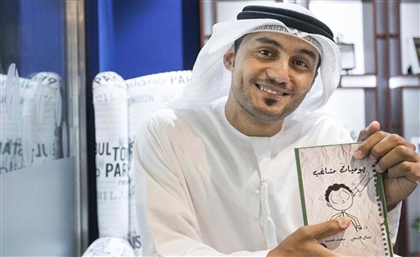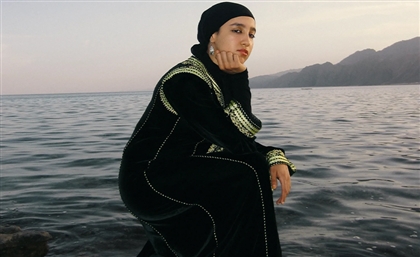Renowned Alexandrian Painter and Sculptor Esmat Dawestashy's Ode to Egypt
With Esmat Dawestashy's 3D fibreglass ankh having been on display at SODIC and CARAVAN's 'The Key' exhibition, Niveen Ghoneim sits down with the artist to uncover the depth of his affection for the motherland and how its character astoundingly manifests itself in all of his works.
For over 50 years, Egypt has been Esmat Dawestashy's muse, its character predominantly present in his work. Born in 1943 in Alexandria, painter and sculptor Esmat Dawestashy has exhibited all over the world. His work is as authentic and original as it gets, as he managed to capture Egypt’s very character. “I would visit the Egyptian museum and feel absolutely in awe of our Ancient Egyptian heritage,” he says. “I would look at our Islamic and Coptic art and wish I was one of those artists who created such splendid things.”
Egypt has always been his muse; its heritage, its people, its diversity, and its folklore were always at the heart of his work, like a declaration of undying love, plain for all to see. This romantic attachment to his native soil has been the subject of his work, a founding principle upon which his art was formed. “I grew up surrounded by mawaled (folkloric Egyptian celebrations and festivals),” he says of his childhood.
The 73-year-old has spent most of his life in his beloved hometown of Alexandria; “Alexandria is to me like the sea is to a fish – if I leave it, I die,” he romances. “I once had a job as a TV director in Cairo, I couldn’t bear for more than six months.”
With over 85 solo exhibitions under his belt, Dawestashy’s love for life and art shows no sign of slowing down. “When I was approached to participate in CARAVAN's The Key installation, I felt absolutely exhilarated because I used to hold two or three exhibitions a year. I don’t get to do that anymore now that I’m old, so I jump at any opportunity to work and create art,” he says. And once again, Egypt was present in every detail, every line, and every motif; “I shaped it like the bride of the Nile on account of the Nile basin crisis; Ancient Egyptians used to make a wooden doll, dress it like a bride, and throw it in the Nile for good harvest – the ritual didn’t involve human sacrifice. I did that to say that we wanted water again, that is why I included details of vegetation,” he explains. “On one side, the ankh’s handle has a man’s face, and on the other, there is a woman, to symbolise life.” They say great love comes from great suffering; it intensifies in the face of adversity, like a defense mechanism. Esmat Dawestashy has been at the forefront of Egypt’s flourishing fine art scene since the early 60s; he has witnessed the movement grow before his eyes; his generation didn’t have the luxuries that we take for granted today, like peace, for instance. Dawestashy has loved his country with infinite fidelity and zeal; the thought of Egyptian artists forsaking his generation’s legacy of romantic nationalism pains beyond words. “Some young artists are West-bound; our hearts were set on Egypt, we didn’t seek fame abroad,” he contemplates. “Even our catalogues are printed in English now, not a single Arabic segment,” he goes on. “We must never forget that Egypt has a lot to offer art-wise, a lot of talents and a lot of artistic problems to be addressed. Egyptian artists sell their work in foreign auction houses because we have none, because artists are marginalised at home and celebrated abroad.”
They say great love comes from great suffering; it intensifies in the face of adversity, like a defense mechanism. Esmat Dawestashy has been at the forefront of Egypt’s flourishing fine art scene since the early 60s; he has witnessed the movement grow before his eyes; his generation didn’t have the luxuries that we take for granted today, like peace, for instance. Dawestashy has loved his country with infinite fidelity and zeal; the thought of Egyptian artists forsaking his generation’s legacy of romantic nationalism pains beyond words. “Some young artists are West-bound; our hearts were set on Egypt, we didn’t seek fame abroad,” he contemplates. “Even our catalogues are printed in English now, not a single Arabic segment,” he goes on. “We must never forget that Egypt has a lot to offer art-wise, a lot of talents and a lot of artistic problems to be addressed. Egyptian artists sell their work in foreign auction houses because we have none, because artists are marginalised at home and celebrated abroad.”
Yet, amid all the abjection, he sees hope; after all, this is the generation that ousted a dictator. “I have faith in them, I believe in their talent and their integrity," he says. "I saw the rise of graffiti and mural art after the revolution as a continuation to the country’s fine art movement.”
Naguib Mahfouz painted a lively image of Egypt with words so sublime they enchanted readers the world over; Dawestashy found inspiration in its Nile, its alleys, and its mawaled – his art personified its effortless charm, its people’s fervent love of life and their humble aspirations. Egypt is a melting pot of Mediterranean Europe, Africa, and Southwestern Asia, a tough subject to portray; yet Dawestashy was one of the few artists who succeeded in capturing its multifaceted and multilayered heritage. To understand his art is to love Egypt.
- Previous Article Islamic Research Complex Declares Tobacco 'Religiously Forbidden'
- Next Article The Middle East to Get Its Own 'Project Runway' Show























